According to Traditional Chinese Medicine, when chi (vital energy) and blood are flowing freely, the body will maintain the balance of yin and yang and disease will disappear. By practicing Qi Gong, chi and blood circulation are improved, balance of yin and yang is restored and the meridians are opened allowing unimpeded flow of chi and blood.
Practicing Qi Gong also has positive results on regulating the respiration and oxygen of the body. An insufficient supply of oxygen can increase the growth of cancer. When the body is rich in oxygen, the cancer cells die. The more one practices Qi Gong, the greater the oxygen content in the body.
If you have cancer, please consult with your primary health care professional before adding this to your treatment plan.
Walking Qi Gong was founded by a Chinese woman named Guo Lin (1906-1984). In 1949 she was diagnosed with uterine cancer and had surgery to remove it. In 1960 she had a re-occurrence and found it had metastasized to her bladder. Another operation was done to remove the cancerous portion of the bladder. Again she had relapsed and was given only 6 months to live. Not willing to give up her fight, she recalled the Qi Gong her grandfather had taught her as a child. She researched and practiced, but did not feel much results. She did more research of the ancient writings and then developed her own practice schedule - two hours everyday and in six months her cancer had subsided.
From her experience she believed that this Qi Gong could help others to have more success in their fight against disease and illness. By 1977 she had achieved such tremendous results that she publicly announced that qi gong could heal cancer, and thus her classes grew to 300-400 students a day. By using this simple method of walking, moving and breathing her students lives were being enhanced and many experienced recovery from their illness and pain free years added to their lives. She left a marvelous legacy of hope and encouragement for all those who suffer from life threatening disease.
Practicing Qi Gong also has positive results on regulating the respiration and oxygen of the body. An insufficient supply of oxygen can increase the growth of cancer. When the body is rich in oxygen, the cancer cells die. The more one practices Qi Gong, the greater the oxygen content in the body.
If you have cancer, please consult with your primary health care professional before adding this to your treatment plan.
Walking Qi Gong was founded by a Chinese woman named Guo Lin (1906-1984). In 1949 she was diagnosed with uterine cancer and had surgery to remove it. In 1960 she had a re-occurrence and found it had metastasized to her bladder. Another operation was done to remove the cancerous portion of the bladder. Again she had relapsed and was given only 6 months to live. Not willing to give up her fight, she recalled the Qi Gong her grandfather had taught her as a child. She researched and practiced, but did not feel much results. She did more research of the ancient writings and then developed her own practice schedule - two hours everyday and in six months her cancer had subsided.
From her experience she believed that this Qi Gong could help others to have more success in their fight against disease and illness. By 1977 she had achieved such tremendous results that she publicly announced that qi gong could heal cancer, and thus her classes grew to 300-400 students a day. By using this simple method of walking, moving and breathing her students lives were being enhanced and many experienced recovery from their illness and pain free years added to their lives. She left a marvelous legacy of hope and encouragement for all those who suffer from life threatening disease.
Members of the Cancer Recovery Clubs in China come together and practice Qi Gong everyday. They are living and breathing monuments of the results which are possible. We can all experience first hand this ancient healing art by learning the slow, meditative movements of Qi Gong.
Cancer You can Beat it! Free Video
Jack has provided the following Cancer You Can Beat It! Video for free download in the hope that many people will benefit from it.
Cancer You can Beat it! Free Video
Jack has provided the following Cancer You Can Beat It! Video for free download in the hope that many people will benefit from it.
You can also try the following books:
Master Lam's Walking Chi Kung
The Cancer Odyssey
You Are How You Move: Experiential Chi Kung
The following exercises will also help to heal the body and improve the immune system function:
How to build up Chi (Qi) to fight off illness and maintain good health
8 Exercises for Fitness, Healing, and Longevity
2 shorter versions on walking Qigong8 Exercises for Fitness, Healing, and Longevity
Basic Qigong version for people who do not have cancer but want to learn simple walking Qigong. For cancer patients please see long detailed version below. I also recommend getting a teacher.
You should not wait until you get cancer to start practicing Qigong. Prevention is better than cure, and you will gain health, vitality, rejuvenation and longevity in the process.
This basic QIGONG WALK is an excellent exercise for everyone to increase Qi quickly. Twenty minutes of walking with inhalation on one foot, followed by another 20 minutes with inhalation on the other foot (a short standing exercise with arm movements is done in between ) is the minimum exercise recommended. Another 20 minutes of stationary or other walking exercises will complete the required 1 hour of Qigong daily that is necessary to maintain optimum health.
Those with serious illnesses and cancers have to do up to 4 hours a day to reverse their diseases.
At the end, I am also including a guided Meditation to aid in your treatment.
There are five parts of the walk that are different from our usual walk, and these changes ensure that the mind is always aware of all the actions (movements and breathing) during the walk, and qi flow is enhanced.
1) THE FOOTSTEP
When we walk, most of us do so almost in a flat-footed manner, with the front part of the foot only minimally inclined upwards as we take each step. Some are actually flat-footed while others drag their feet.

In the Qigong walk, we deliberately step on our heel, with the foot inclined about 30 degrees upwards as we take each step. Doing so is particularly good for qi flow in the kidney meridian channels, which is essential for general health.
Note that the legs are always relaxed and slightly bent at the knees. If you straighten and stiffen your legs, and do the Qigong step, you will be walking Nazi-style.
2) THE ARM SWING
In our usual walk, we swing the opposite arm forward as we take each step. This swing is automatic. Nobody walks normally without moving the arms. In the Qigong Walk, the arms are swung to the front of the body instead, with the hands coming near the lower main energy centre ( Dan Tien ) which is situated about three fingerbreadths below the navel ( and about the same distance internally ). On the backswing, the hands come beside the buttocks but not as far back as in the usual walk.
There are differences in the hand position for those with health problems. For healthy people, the palms face the body, whereas they face the ground or upwards for different diseases. For some diseases, the fingers point downwards.
3) MODIFIED BREATHING
When we walk, our breathing is so spontaneous that we hardly think about it. In the Qigong Walk, the breathing is made mindful by modifying the inhalation. We inhale twice ( two sniffs ) and then exhale as usual. It is possible to do so only with conscious-breathing. Breathing is through the nose, with the tongue always touching the upper palate.
The breathing is coordinated with the footstep, and since the latter is coordinated with the arm-swing, all three components are therefore consciously coordinated.
In the basic walk, the inhalation is simultaneous with the foot that takes the first step. Males start with the left foot, and females with the right. As explained previously, there are differences in the Yin and Yang ( female and male ) qi.
4) SIDEWAYS BODY SWING
In our usual walk, we actually swing the body very slightly to balance it as we lift each leg alternately to step forward. This is necessary since the centre of gravity is shifted as we lift each leg. In the Qigong Walk, the swing is exaggerated, and becomes obvious if the walk is done slowly.
5) HEAD TURNING
In the basic Qigong Walk, we turn the head about 60 degrees sideways every 2,4,6 or 8 steps ( usually 4 ). This is coordinated with the feet, with the head always turning towards the side of the foot that is in front. This will facilitate the incorporation of modifications when the variations of the Qigong Walk are learned later.
During the Qigong Walk, look into the distant horizon and not at your feet. Initially, walk at whatever pace is comfortable for you. Different paces are recommended for different diseases.
The proper starting stance is unique but will not be described here. It will certainly be taught if you learn from an instructor.
This basic Qigong Walk is an excellent exercise for everyone to increase qi quickly. Twenty minutes of walking with inhalation on one foot, followed by another 20 minutes with inhalation on the other foot ( a short standing exercise with arm movements is done in between ) is the minimum exercise recommended. Another 20 minutes of stationary or other walking exercises will complete the required 1 hour of Qigong daily that is necessary to maintain optimum health.
Guo Lin walking Qigong and the standing Guo Lin Qigong practices.
These are the forms used by Guo Lin to treat her own cancer, and used to treat the cancer of many others.
The Guo Lin Walking QiGong:
Starting position: From a normal standing position, place your right leg back one step.
1. Inhale twice with two half-steps, left hand's Laogong point in front of dantien:
Place your left hand's Laogong point in front of your dantien. Keep the right arm hanging at your side. Move your right leg even with the left and pause, resting it on the ball of the foot. While the leg is moving, inhale halfway and pause the breath and foot briefly. Then take another half-step forward with the right leg, filling your lungs as you do. Pause briefly and hold your breath. Keep your left palm in front of your dantien.
2. Exhale with one full step and switch arms:
Now take the next step, a full step, with your left leg, landing your foot normally, ahead of the right. Exhale as you step. As you move your leg, switch your arms easily and normally, placing your right hand in front of your dantien, and the left arm by your side.
3. Inhale twice with two half-steps, right hand's Laogong point in front of dantien:
Move your right leg even with the left and pause, resting it on the ball of the foot. While the leg is moving, inhale halfway and pause the breath and foot briefly. Then take
another half-step forward with the right leg, filling your lungs as you do. Pause and hold your breath. Keep your right palm in front of your dantien.
4. Exhale with one full step and switch arms:
Now take the next step, a full step, with your left leg, landing your foot normally, ahead of the right. Exhale as you step. As you move your leg, switch your arms easily and normally, placing your left hand in front of your dantien, and the right arm by your side.

Continue this ( 1 through 4 ) in a gentle easy rhythm. You will find it easier as you practice. You may walk in a slow, medium or fast speed. You may walk for some time;
hours even. About 1/2 way through your walk, switch legs, doing the half-step step with the left leg.
Practice this for up to 2 hours a day
This is from http://www.guolinqigong.net/
Long Version:
PREPARATORY EXERCISE (YU BEI GONG)
This is the starting mode of practice performed at the beginning of every session in order to relax our mind and body, open energy channels and stimulate circulation of energy and blood etc.
The preparatory exercise consists of three stages:
1. Relaxed Standing (song jing zhan li)
2. Three Cycles Breathing — Middle Dantian (zhong dantian san hu xi)
3. Three Rounds of Opening & Closing — Middle Dantian (zhong dantian san kai he)
RELAXED STANDING (SONG JING ZHAN LI)
1. Parallel Feet Standing (Liang jiao ping kai)
Stand with the feet a shoulder width apart and parallel to each other
2. Knee (Liang Qi Wei Wan)
The joint of the knees should be relaxed and slightly bent without the caps exceeding toes. Weight should be evenly distributed between both feet. (FIG. 1-1)
.jpg)
3. Hips & Waist (song yao song kua)
The hips and waist should be relaxed and withdraw the buttocks as if stopping a bowel movement. This is to ensure free flow of blood & energy between the feet & hips.
4. Lower Abdomen (siao fu nei shou)
Hold the lower abdomen slightly in without forcing it. This helps to relax the hips and waist, and keep lower spine straight and evenly aligned with the upper spine and neck.
5. Chest & Spine (han xiong ba bei)
Keep the chest as loose as possible by slightly rounding the shoulder and relax the thoracic cavity and also keep the spine relaxed & straight without bending and stretch the vertebrae upwards by raising the back of the neck up. Tension in chest and bent back inhibits diaphramic breathing and block circulation of energy.
6. Shoulder & Elbows (chui jian zhui zhou)
Elbows & shoulder should be relaxed by letting the shoulder droop, the elbows lowered, and slightly bent.
7. Armpit & Wrist (Shi Yi Sung Wan)
All joints of the wrists, arms and hands hanging loosely down the side with armpit exposed. The fingers should be slightly closed without force.
Patients with high blood pressure, high cholesterol and diabetes should place their hands with fingers pointing downwards (FIG. 1.2)
Those with hypotension, hypoglycemia (low blood sugar), and anemia (lack of blood) should place their hands in front of lower abdomen with palms facing upwards. (FIG. 1-3)
.jpg) All others should place their hands at the sides of the hips with fingers of both hands bending like half fist. (FIG. 1-1)
All others should place their hands at the sides of the hips with fingers of both hands bending like half fist. (FIG. 1-1)8.Tongue (she di shang e)
Touch the edge of upper hard palate with the tip of tongue without force. This allows bridge for the Governing channel, that runs up the spine from huiyin point (a point between anus and reproduction organ) passing through baihui point (top of the head) to the edge of the upper palate to meet the Conception Channel, that runs up from huiyin point through the center line in the front body to the underside of the tongue. It also stimulates secretion of saliva from the glands beneath the tongue. This saliva should be swallowed from time to time as it collects in the mouth by three gulps and imagine it reaching the middle dantian.
9. Eyes (Zheran Bi Mu)
Look straight ahead and then close the eyes gently without changing the direction of the eyes.
10. Head (baihui chao tian)
Keep the head up right as if it is suspended by a string attached to the crown. Tuck the chin slightly inwards the throat. Do not tilt the head forwards or backwards, right or left. The neck muscles should not be tense.
Calm & Relax (xin an shen ning)
When the mind is calm and relaxed and excludes of all distracting thoughts, it helps all parts of the body and the limbs to be kept natural, neither tense nor slack and allows smooth circulation of blood and energy to all parts of the body. At the beginning, Guolin Qigong applies mental counting numbers 60-120 i.e. 1-2 minutes to free the mind from various distracting thoughts in order to achieve a relaxed and calm mind.
THREE CYCLES OF BREATHING — MIDDLE DANTIAN (ZHONG DANTIAN SAN HU XI)
This is an exercise of respiration regulation. Breathing in a prescribed manner three times in succession will set up a condition reflex in the respiration nerve Centre, helping to bring about gradual inhibition of the cerebrum so that the brain can get rest and relaxed. So, the three cycles of breathing should be done seriously at all stages.

Starting Position
Continue from stand in relaxed standing position.
Method A — For General and Chronic Disease Sufferers
1 . Move both hands slowly and gently from the sides to the front of abdomen with one hand over the other in the following fashion:
Place the hukuo (the part of the hand between forefinger and the thumb) of the left hand (right hand for women) at the navel, with the center of the palm inner (laogong) pressing on the middle dantian (zhong dantian).
2. Then place the right palm (left palm for women) on top of the back of the left hand so that the inner laogong point of the right hand is on top of outer laogong point of the left hand. (FIG. 1-4)
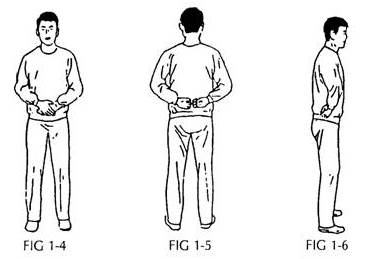
3. When both hands are in position, start to do the breathing exercise, first exhaling (hu) from the mouth, then inhaling (xi) through the nose and follow by a natural breathing. Breathe gently and slowly, steadily and deeply never try to take a deep breath with undue force. Keep your waist, hips, knees and all joints of the body relaxed. One exhalation followed by an inhalation and a natural breathing is called one cycle of breathing. Repeat three times or three cycles.
Method B — For Cancer Patients
1. The process of exhalation and inhalation is different for cancer patients. Cancer patients would be required to start with inhale (xi-) through nose and then exhale (hu-) through mouth and follow by a natural breathing (ping). Repeat three times.
1. The process of exhalation and inhalation is different for cancer patients. Cancer patients would be required to start with inhale (xi-) through nose and then exhale (hu-) through mouth and follow by a natural breathing (ping). Repeat three times.
2. Cancers at different parts of the body call for different positions of both hands.
A) In general, those with cancer at above shanzhong point (between nipples) such as head, nose, mouth and chest etc. should position both hands at zhong dantian as per Method A (FIG. 1-4).
B) Patients with cancer found between shanzhong point and zhong dantian such as liver, stomach, gallbladder and pancreas etc,should move both hands from the sides to the front of zhong dantian and after contacting both thumbs move both hands by following the waist line from front to back and position the outer laogongs (back of hands) against shenshu points with the tips of thumb and middle finger contacted (FIG. 1-5).
Cancer at the back of abdomen such as kidney problems should position their outer laogongs on both hands on the side of waist with the tips of the thumb and middle finger contacted (FIG. 1-6).
THREE ROUNDS OF OPENING and CLOSING — MIDDLE DANTIAN (ZHONG DANTIAN SAN KAI HE)
The three rounds of opening and closing — zhong dantian is to open the energizer of the vital energy. This energizer (zhong dantian) is situated at a point 40 mm below the navel and inwards by similar distance. When this point is energized, the inner energy can flow through the energy channels, balance Yin & Yang, valuable energy can be received and toxic energy can be released from the body thus achieving the therapeutic purpose. Therefore, these three rounds of opening and closing - zhong dantian must be practised during preparatory, main exercise and concluding exercises or at any time during change of forms.
Starting Position
Continue from three cycles of breathing.
General or Balanced Method
1. After the last cycle of breathing, slowly place/move hands to the front of zhong dantian with both inner laogongs facing down and about 150 mm away from body. Fingers pointing forward. Breathe normally.
2. Then, turn the back of both hands facing each other (FIG. 1-7) and slowly move hands away from zhong dantian horizontally towards the sides. This is called "opening (kai)".
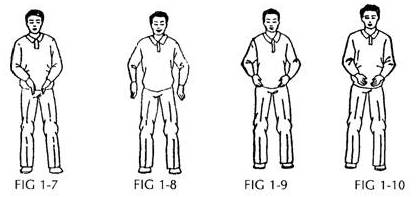
3. When the hands have reached shoulder width (FIG. 1-8), turn them so that the inner laogongs face each other and slowly move them together towards the zhong dantian (FIG. 1-9). This is called "closing (he)".
4. When the hands meet (FIG. 1-10), repeat two more times.
Enrich, Release, Raise and Lowering Methods
1. When the hands move away with palms facing the ground is called "release" method, hands move away with palms facing upwards is called "raise" method and hands move away with palms facing body and fingers pointing the ground is called "lowering" method. Hands move away with palms facing each other or zhong dantian is called "Enrich" method.
1. When the hands move away with palms facing the ground is called "release" method, hands move away with palms facing upwards is called "raise" method and hands move away with palms facing body and fingers pointing the ground is called "lowering" method. Hands move away with palms facing each other or zhong dantian is called "Enrich" method.
2. Hypotension or hypo-indicated patients practise with palms facing upwards can quickly achieve therapeutic results (FIG. 1-11,12,13). When they have recovered, they should slowly change to "balance" method, i.e. let the palms slowly change and incline to face each other or zhong dantian in order to maintain therapeutic results.
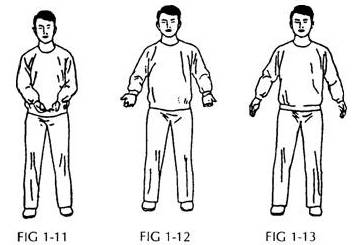
3. Cancer patients must practise with the palms facing the ground and the hands must be placed slightly away from the body (approximately 330 mm) with fingers slightly inclined downward (FIG. 1-14,15,16,17).
4. For Hypertension or hyper-indicated patients, their palms should face the body and fingers pointing the ground (FIG. 1-18,19,20).
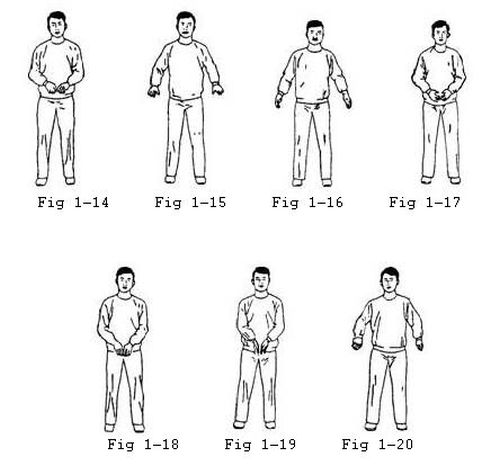
Adopted from The Art of Qigong, produced by Persatuan Guolin Qigong Malaysia
WALKING EXERCISE (ZI RAN XING GONG)
WALKING
After the preparatory exercise, open eyes and walk ahead as if you were taking a stroll but with special demands of footwork according to type of ailments. Hypertension & heart disease patients of either sex move the left foot forward first, while liver, gallbladder & eyes disease patients move the right foot forward first.
For all others, males move the left foot forward and females move the right foot forward first.
Starting Position
Continue from three rounds of opening & closing — middle dantian
Method — General
1. After completion the 3 rounds of opening and closing —zhong dantian, slowly move the hands to the sides of the hips (200 mm away from hips) at relaxed standing position, then slowly move the right hand (left hand for women) to the front of zhong dantian (about 100 mm apart).
2. Slowly move the body weight to the right foot (left foot for women) and bring the left foot (right foot for women) near the mid-point of the right foot 100-mm apart with toes pointing downward and touch the ground with the toes (FIG. 1-21) and then advance the left foot forward with heels down, toes up without strength and the knees slightly bent (FIG. 1-22) and put the left sole flat on ground (FIG. 1- 23). This is called "touch and start walking (dian jiao qi bu)" . The step should not be too far apart. It is recommended to be half the normal step. The heel down and toes up is to open kidney energy channel, as most of the chronic disease patients are weak in kidney functioning.
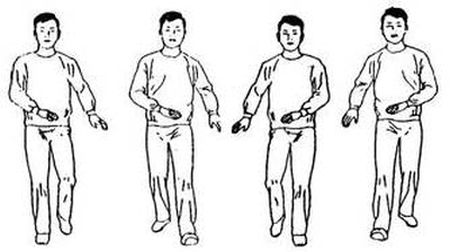
FIG 1-21 FIG 1-22 FIG 1-23 FIG 1-24
3. Advance the right foot forward with heel down, toes up (FIG. 1-24) while simultaneously move the left hand to the front of zhong dantianand the right hand to the side of the right hip then put the sole down flat on ground.
4. Advance the left foot forward with heel down, toes up while simultaneously move the right hand to the front of zhong dantian, left hand to the side of the left hip and then put the left sole down flat on ground. Continue to move forward for 20 minutes, keep the waist, lower back and hips relaxed and both feet in parallel while walking.
5. Advance the rear foot forward parallel to the front foot.
6. Stand at relaxed standing position, do 3 rounds of opening and closing — middle dantian.
7. Repeat Step 1 to 5 as above but with right foot (left foot for women) to advance first.
8. After completion of the walking exercise, stand at relaxed standing position for a while, then perform concluding exercise.
The movement should be rhythmic, unstrained and natural. All joints of the limbs should be relaxed. The principles of roundness, softness and extensiveness must be applied. Armpits should kept exposed throughout the exercise so as to ensure the smooth circulation of inner energy.
ARM SWING
The arm swing with the palms facing the ground is called "release" method, this method must be practiced by cancer patients initially (FIG. 1-25,26,27,28).
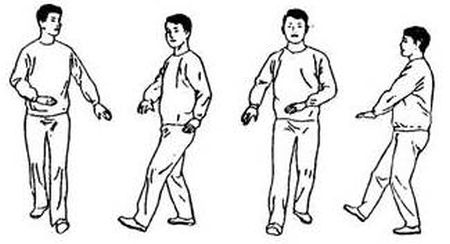
FIG 1-25 FIG 1-26 FIG 1-27 FIG 1-28
The hands move away from Zhong dantian with palms facing to the ground while swing back with palm face to Zhong dantian (FIG. 1-29) is called "balance" method. This method should be practised by the cancer patients after they have recovered for some time.
The hands swinging with palms and fingers facing downward (FIG. 1-30) is called "lowering" method. This method can lower the hyper-indicate ailments such as high blood pressure and blood sugar level.
The hands swinging with the palms facing upward (FIG 1-31) is called "raise" method. This method can improve the health for those with hypo-indicated ailments. All others should swing with the palms facing dantian(FIG. 1-32) which is called "enrich" method. This method should also be practised by hyper or hypo-indicate patients who have recovered from the sickness.
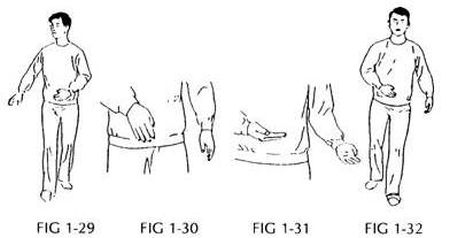
RESPIRATION
1. Normally, moderate strength nasal respiration is used during natural walking. Nasal respiration means inhale and exhale through the nose. There is a slight breezing noise during inhalation and exhalation. All inhalation and exhalation should only be heard by yourself. In nasal respiration for the natural walking exercise, two short inhalation with one breath (i.e xi-xi hu-). The two inhalations must last as long as the one exhalation in order to balance our breath.
2. Nasal respiration must be done in co-ordination with walking and arm swinging. When the heel touches ground for the first step, inhale twice (xi-xi), followed by exhaling once (hu-) when heel touches ground for the second step.
HEAD TURNING
When left foot moves forward first with heel touching on the ground, inhale twice, when the right foot moves forward, turn the head to the right by 45° angle simultaneously, followed by exhaling once when the right heel touches the ground. If you feel that the head turn is too quick and uncomfortable, the head turning can be performed at every 4,6 or 8 walking steps.
IMPORTANT POINTS TO REMEMBER
1. The amount of inhalation and exhalation must be balanced. Some qigong call for inhalation more than exhalation or inhalation less than exhalation. This can cause imbalance of breath and side effects may happen.
2. Nasal Respiration is very seldom mentioned in the ancient Qigong literature. However, practical experience in China over the past 20 years have shown that this nasal respiration in co-ordination with walking and arm movennent exercise created by Master Guo Lin is particularly suitable for treatment of chronic diseases and also definitely can prolong the life of cancer patients and alleviate their symptoms.
3. During practice, both hands swing away and return to dantian. Do not "throw" the hands in order to prevent inner energy loss from hands.
4. When inhaling twice, the diaphragm must feel some vibration. Do not force breathing with nose.
5. When doing the first step forward, males and females with heart and heart related disease must forward with the left foot first. Liver, gallbladder and eyes patients must forward first step with right foot and toes landing on the ground. For all others, males should forward first step with left foot while females forward first step with right foot.
ADDITIONAL INFORMATION
TONGUE
During walking, the tip of the tongue must touch the edge of the hard palate jointed to the upper teeth without force. This bridge and improve the circulation of inner energy from the governing channel to the conception channel.
EYES
During practice, both eyes should look straight ahead and follow where the head turns to and at horizontal position to prevent the head from tilting. When looking at something, you should allow yourself to be in a state that you seem to "look at them but at the same time see nothing" as well "see things without paying attention". In this way, your mind can stay relaxed and tranquil with no distracting thoughts.
SALIVA
During exercise, saliva may increase and accumulate in the mouth. Do not spit it out. Stop walking and swallow slowly in three gulps at relaxed standing position, imagining that the saliva passing through the throat and stomach and finally reaching zhong dantian. Then do a three rounds of opening and closing-zhong dantian and continue walking.
WALKING SPEED
Natural walking should be performed naturally. The speed of walking and respiration is according to the body and health condition of each individual. The aim is to achieve rhythmic and unstrained breathing without gasping for breath. In general, walking at a speed of 20-30 steps per min is suitable while some may walk with a speed of 100 steps per min and achieve good results.
CONCLUDING EXERCISE - (SHOU GONG)
1. After walking for approximately 40 minutes, return to the relaxed standing position with eyes closed.
2. Perform three rounds of opening and closing —zhong dantian
3. Perform three cycles of breathing-zhong dantian
4. Perform relaxed standing for 2 minutes or more by mental counting the numbers.
The session takes approximately 40 minutes. Very sick and weak patients can reduce the time to suit, however they must increase the time as they progress with their health accordingly. In general, walking for 20 minutes then stop in relaxed standing position for a while and then perform 3 rounds of opening and closing-middle dantian. Then change foot and walk again for 20 minutes followed by concluding exercise.
In between each session, take a break by sitting down for 10-15 mins to allow the inner energy to be distributed to the whole body.
Adopted from The Art of Qigong, produced by Persatuan Guolin Qigong Malaysia
A guided meditation to aid in your treatment. This is not from Guo Lin's family Qigong.
This can be done standing, sitting or lying down, in addition to the Guo Lin Qigongs and your other treatments.
Begin by doing the Microcosmic orbit.
Begin by doing the Microcosmic orbit.
Once you are able to get the circulation going, imaging or visualize that every time your Qi passes the Mingmen (Life Gate) point at the small of your back, small (tiny) balls of golden Qi begin to circulate with each orbit, in addition to the original. On each orbit they increase in number.
Once you feel you have a good number of golden Qi balls, the next time they pass the Mingmen, they begin to spread out and travel around your body. Every time they find a cancer cell, they burst, killing the cancer cells. You will see a tiny dark light go out, for each cancer cell. The golden light begins to permeate your body.
Once you feel you have a good number of golden Qi balls, the next time they pass the Mingmen, they begin to spread out and travel around your body. Every time they find a cancer cell, they burst, killing the cancer cells. You will see a tiny dark light go out, for each cancer cell. The golden light begins to permeate your body.
If you start running out, start the orbit again and create more golden Qi balls.
Do this two or three times a day, spread out, for two weeks to a month. After this time has passed, visualize or imagine that there are fewer and fewer cancer cells for the golden Qi balls to find. You will be feeling better, stronger and healthier. At some point between two and six months, visualize or imagine yourself cancer free. The golden Qi balls can't find a single cancer cell to destroy. As you continue to do the Microcosmic orbit, the Qi balls collect in various places in your body to help you stay healthy. These pockets can be your lymph nodes, your intestinal tract, behind your eyes, anywhere you feel is right.
You can use these saved Qi balls to fight any future illness.
Additional posts on Healing and Meditation:
My favorite Meditation for Self-Healing by Yogi Bhajan
Breathing exercise to overcome all of your physical shortcomings
Also try Bliss Meditation
Please also try my heart-opening exercise/visualization is about opening your heart to Love
Resources:
Additional posts on Healing and Meditation:
My favorite Meditation for Self-Healing by Yogi Bhajan
Breathing exercise to overcome all of your physical shortcomings
Also try Bliss Meditation
Please also try my heart-opening exercise/visualization is about opening your heart to Love
Resources:
Spring Forest Qigong - Small Universe - Meditation
Three Treasures Qigong Healing Meditation
Qigong Meditation: Embryonic Breathing
Three Treasures Qigong Healing Meditation
Qigong Meditation: Embryonic Breathing



This sounds good..but how do i deal with breathing problems...emphysema
ReplyDelete